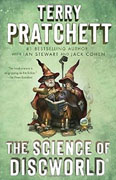The Science of Discworld
Terry Pratchett, Ian Stewart and Jack Cohen
book reviews:
· general fiction
· chick lit/romance
· sci-fi/fantasy
· graphic novels
· nonfiction
· audio books
· author interviews
· children's books @
curledupkids.com
· DVD reviews @
curledupdvd.com
newsletter
win books
buy online
links
home
for authors
& publishers
for reviewers

 |
The Science of Discworld: A Novel Terry Pratchett, Ian Stewart and Jack Cohen Anchor Paperback 432 pages June 2014 |
|
Terry Pratchett’s Discworld runs on magic. And a little bit of the element Narrativium. But mostly on magic. Clearly, then, Discworld is purely fictional and has nothing at all in common with our world.
In the beginning, there was an experiment intended to produce heat for Unseen University (while simultaneously expanding the boundaries of knowledge, or course). It will come as no surprise to anyone who has read any of the Discworld novels that the experiment goes sideways and creates a new universe on the campus’s squash court. Not a normal universe, mind you, but one in which planets are spherical. Watching the birth and evolution of a strange new world that defies the laws of magic (and those laws are as rigid and logical as the laws of physics—which is to say, they wiggle about quite a lot, but experts in the field are rigidly and illogically devoted to their belief in the inflexibility of said laws) baffles the great and powerful wizards. Readers are considerably luckier in this respect. We have Jack Cohen, a professor of biology and honorary professor of mathematics at the University of Warwick, and Ian Stewart, a professor of mathematics at the University of Warwick, popping in for alternate chapters in order to explain what is happening in the baby Roundworld universe. Naturally there will be differences between a disc-shaped world that travels through space on the back of a turtle and a free-ranging globe. For example, in Discworld, wizards concern themselves with determining the exact speed at which dark travels while Roundworld scientists (when they finally appear) will be certain that the speed of light is limited. There are also far more similarities than one might expect, but perhaps it takes a scientist (or two) to point those out. Stewart and Cohen are akin to wizards in their dazzling ability to counter Pratchett’s unfolding Discworld tale with an accurate and enlightening explanation of how universes are conceived, birthed, and nurtured to maturity. They’ve also incorporated a few extras, such as insider notes on accidental scientific discoveries and the surprising resemblance of Roundworld lifeforms to the Unseen University Librarian. Feel free to read only the Discworld story, only the scientific interludes, or the whole shebang in order—entirely up to you. Whichever path you take, you’ll find The Science of Discworld Originally published on Curled Up With A Good Book at www.curledup.com. © Deborah Adams, 2014 |
| Also by Terry Pratchett: |
|
|
|
 Click here to learn more about this month's sponsor! |
|
| fiction · sf/f · comic books · nonfiction · audio newsletter · free book contest · buy books online review index · links · · authors & publishers reviewers |
|
| site by ELBO Computing Resources, Inc. | |
 Or … could there be a connection between magic and science? Can the wizardry of Discworld shed any light on hard, rational, solid Earthly physics? The authors of
Or … could there be a connection between magic and science? Can the wizardry of Discworld shed any light on hard, rational, solid Earthly physics? The authors of